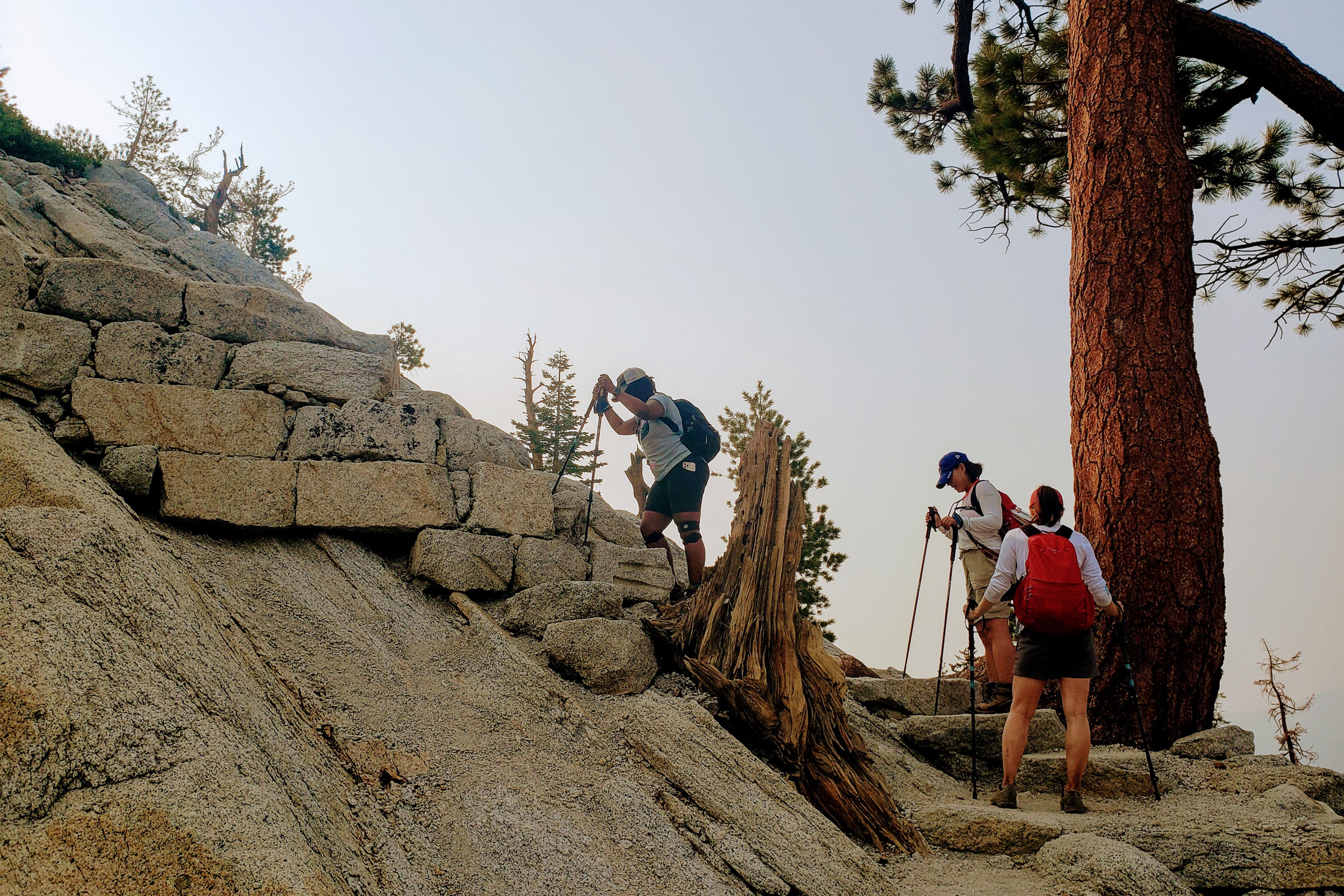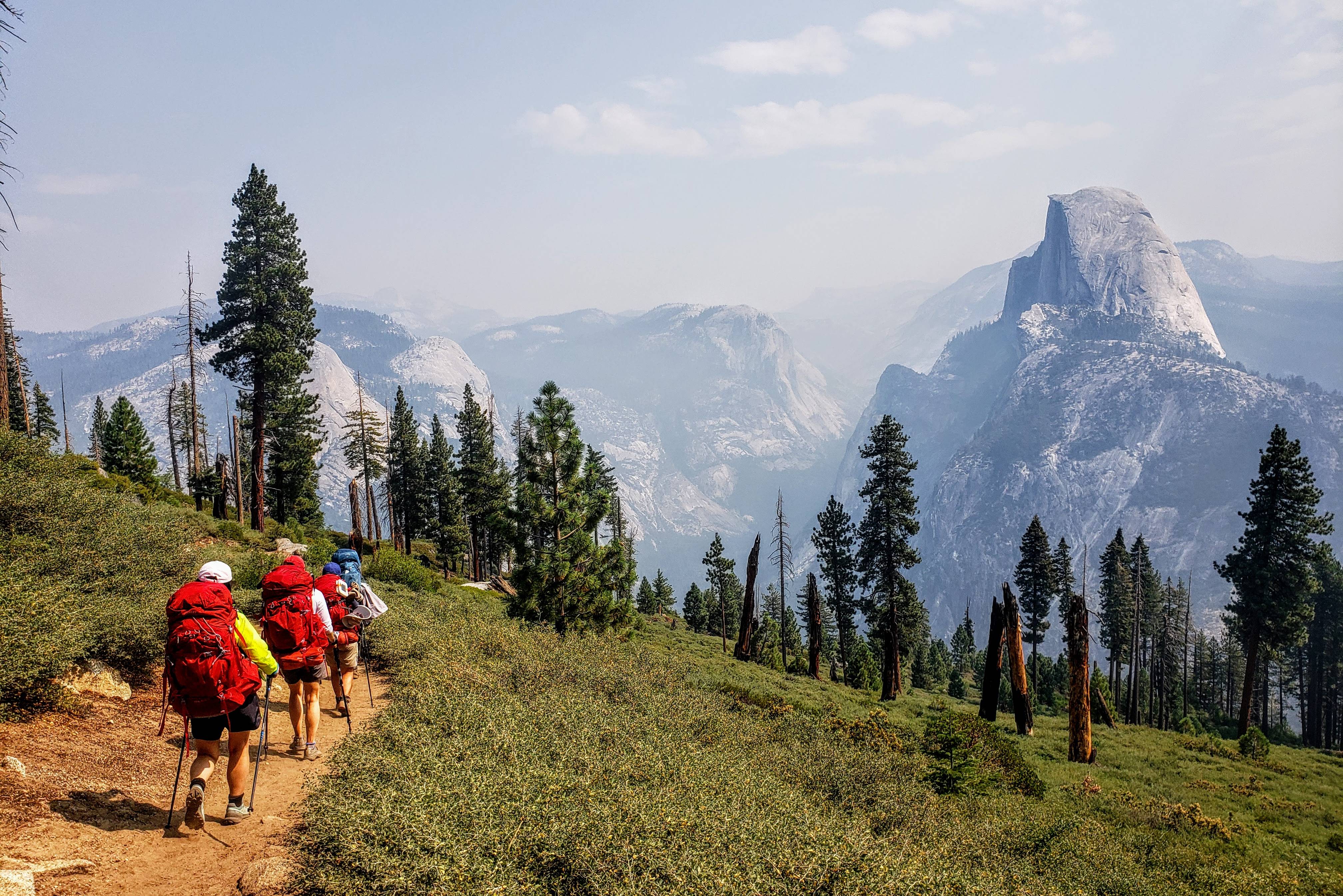Most people view trekking poles as only for the injured or the elderly. And there’s stigma around a ‘need’ for poles. So we’re shedding light on the awesomeness of trekking poles.
Trekking poles hold a negative connotation sustained by a stubborn “I don’t need ‘em!” perception. Yet, this tactful gear aligns with determined, resilient, lifelong adventurers.
It’s not a need but a want that drives us to wrap our fingers around their ready handles. And once you experience the “click, click” rhythm on the trail, it feels foolish to explore without them.
Here, we dig into the multifaceted benefits of trekking poles. They’re as fun as they are useful. They’re badass. Think of trekking poles as a tool, not a crutch.
From hiking faster to navigating tricky terrain, we’re celebrating the many reasons to give trekking poles a try. Plus, we get into how to use them and recommend our favorites. Check ’em out.
Why Try Trekking Poles?

1. Get a Full-Body Workout
Backpacking guarantees a lower body workout. But what about biceps, triceps, and forearms? Rather than noodles dangling at your side, or thumbs wedged into shoulder straps, poles allow your arms to join the steady dance.
Ascents and descents are like a day at the gym for the upper body, while the flats engage core muscles. The next day, your quads and calves will still scream for stretches, but now your arms and abs will be looking for love too.
2. They Help You Hike Faster
Whether due to inertia, or the poles physically pulling me forward, my hiking pace increases with poles. Charging switchbacks over a pass or slogging at the end of a long trail, poles tap-tap me into a rhythm. The temptation to stop dissipates. I can focus on one hand in front of the other, rather than my boots, which feel like cement.
Ultramarathoners use trekking poles, and their motto is “relentless forward progression.” If you want to move faster, for longer periods, seize the poles.
3. Cross Rivers and Snow Fields
On day one of my John Muir Trail thru-hike, snowfields concealed our track at the top of a scree-covered pass. Every few steps I post-holed, and gravity yanked at me and my rucksack. Fortunately, I had my brand-new trekking poles to dig into the snow and keep me upright.
Poles provide balance, a third and fourth point of contact, and friction in snow or wedged between rocks for river crossings. They can even be used to pole vault across rivers in New Zealand (not wholly recommended).

4. Quicker Return After Injury (ACL Tear, Anyone?)
When my partner’s mom underwent double knee replacement surgery, she bought herself collapsible LEKI trekking poles. Years later, she still totes them everywhere, saying, “I don’t know what I would do without these.”
The default post-surgery cane can induce feelings of old age and incapacity. You deserve to feel confident, strong, and prepared to work hard to return to the trail. (Note: Talk to your doctor about this alternative.)
Another GearJunkie staff member can attest: Limping around with a broken ankle in a boot is much cooler with a ski or trekking pole. Give yourself extra support, help find your footing — and look cool doing it.
5. Hand Health on Trail
With trekking poles, the hands are lifted near heart level, and in constant motion, allowing blood to flow freely. This produces light and nimble hands, able to accomplish simple but important tasks like unclipping buckles, tying knots, or opening bear containers.
6. Badass Photographs
Fact: A photograph of a backpacker with poles looks more epic than a photograph without. Arms out, tips up. Hand on hip with a lean on both poles. Starfish. Take your pick. Trekking poles add depth to the frame and your trail story.

7. Better Your Posture
No one wants their favorite outdoor activity to give them a hunchback. Set at the proper height, poles align your neck with your upper and lower back. Poles also reduce neck strain and decrease lower back pain.
You’ll feel and look more confident than your trailmates who are withering under the weight of their pack, struggling to stand upright against almighty gravity.
8. No Tent Poles? No Problem
Many of today’s ultralight backpacking tents are packaged without traditional tent poles. Instead, they require trekking poles (which you’ll already want to have) to properly build the shelter.
Make sure to practice setup at home. Better yet, test out the tent’s ability to withstand wind and rain in your backyard before relying on it for a multiday trip.
9. Carry More Weight
With poles, the weight in your pack is better distributed throughout your body, allowing you to safely and comfortably carry additional pounds. Whether rocking a smaller torso, schlepping extra weight for a trailmate, or hauling additional days of food on a thru-hike, poles will help balance the load.
10. Play ‘Star Wars’
Backpacking is more about having loads of fun than bagging miles and peaks. Sometimes the best way to get through an arduous hike is to use your imagination and turn into a Jedi. Suddenly, your trekking pole is a lightsaber, beaming a heroic blue glow while your trailmate’s exudes an ominous red. (Telescoping poles add to the realness of this scenario.)
Pro tip: Be sure to reenact scenes from the safety of a wide, flat campground, not at the edge of a cliff. The mountains are not a movie set, and Princess Lea will not rescue you. I repeat, the SOS button on your Garmin inReach does not call the Millennium Falcon.
Types of Trekking Poles

When choosing the best trekking poles for you, consider the material of the pole and the handle, and how much they retract/fold.
The pole body is either aluminum or carbon fiber. Metal poles are more affordable, but heavier, whereas carbon poles are more expensive, but lighter.
The handle is either rubber, foam, or cork. Cork is known to decrease sweating. I was skeptical until my first backpack trip with my rubber-handled poles. I immediately returned them.
Lastly is how compact the poles are when not in use. After multiple tramping adventures in the Southern Hemisphere, I learned the additional cost for foldable poles is worthwhile. I invested in the Women’s LEKI Micro Vario Cor-Tec TA Trekking Poles and have recommended them ever since.
How to Use Trekking Poles: Pro Tips

Always use two at a time to avoid overcompensating on one side of your body, which can lead to injury or strain.
Regularly adjust poles based on the slope of the trail. Your elbows should make a right angle between your forearms and biceps, with your shoulders back, and your forearms parallel to the ground.
Move your arms and hands naturally as if you did not have poles. Grip lightly and let them swing with your walk. As your left foot steps forward, your right hand shifts forward, followed by your pole.
Every step also has a pole plant. When negotiating tall stairs, you may plant two poles at a time, like crutches, but this is the exception. Relax, and use the poles as a natural extension of your body.
Let’s make the outdoor industry more welcoming and accessible, and change our perspective on gear choices. From skiing in jeans to packing your bookbag for a day hike, it’s time to dispense high fives for resilient efforts to get outside.
On my third backpacking trip ever, at age 28, I refused trekking poles. Not anymore.

I invite you to give trekking poles a chance. Join the cool club of folks willing to pull out all the stops — and the poles — to go the distance. And may the poles be with you.









